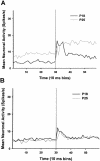Developmental changes in eyeblink conditioning and neuronal activity in the pontine nuclei
- PMID: 14557606
- PMCID: PMC217999
- DOI: 10.1101/lm.63703
Developmental changes in eyeblink conditioning and neuronal activity in the pontine nuclei
Abstract
Neuronal activity was recorded in the pontine nuclei of developing rats during eyeblink conditioning on postnatal days 17-18 (P17-P18) or P24-P25. A pretraining session consisted of unpaired presentations of a 300-msec tone conditioned stimulus (CS) and a 10-msec periorbital shock unconditioned stimulus (US). Five paired training sessions followed the unpaired session, consisting of 100 trials of the CS paired with the US. The rats trained on P24-P25 exhibited significantly more conditioned responses (CRs) than the rats trained on P17-P18, although both groups produced CRs by the end of training. Ontogenetic increases in pre-CS and stimulus-elicited activity in the pontine nuclei were observed during the pretraining session and after paired training. The activity of pontine units was greater on trials with CRs relative to trials without CRs in rats trained on P24-P25, but almost no CR-related modulation was observed in the pontine units of rats trained on P17-P18. The findings indicate that pontine neuronal responses to the CS and modulation of pontine activity by the cerebellum and red nucleus undergo substantial postnatal maturation. The developmental changes in pontine neuronal activity might play a significant role in the ontogeny of eyeblink conditioning.
Figures








References
-
- Aitkin, L.M. and Boyd, J. 1978. Acoustic input to the lateral pontine nuclei. Hear. Res. 1: 67–77. - PubMed
-
- Andersson, G., Garwicz, M., and Hesslow, G. 1988. Evidence for a GABA-mediated cerebellar inhibition of the inferior olive in the cat. Exp. Brain Res. 72: 450–456. - PubMed
-
- Attwell, P.J., Cooke, S.F., and Yeo, C.H. 2002. Cerebellar function in consolidation of a motor memory. Neuron 34: 1011–1020. - PubMed
-
- Bao S., Chen, L., and Thompson, R.F. 2000. Learning- and cerebellum-dependent neuronal activity in the lateral pontine nucleus. Behav. Neurosci. 114: 254–261. - PubMed
Publication types
MeSH terms
Grants and funding
LinkOut - more resources
Full Text Sources
